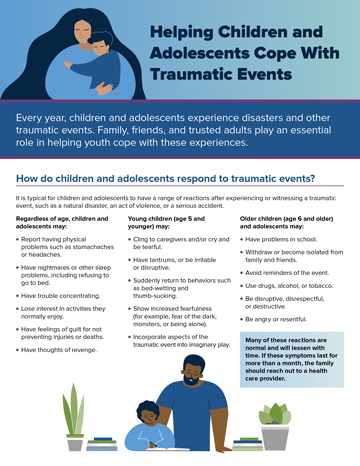 Each year, children and adolescents experience disasters and other traumatic events. Parents, rescue workers, and members of the larger community can help children start the process of recovery and overcome these experiences.
Each year, children and adolescents experience disasters and other traumatic events. Parents, rescue workers, and members of the larger community can help children start the process of recovery and overcome these experiences.
What is trauma?
When people think of trauma, they often focus on physical injuries. However, people also can experience psychological trauma after witnessing or experiencing distressing events.
Trauma can be caused by natural disasters such as hurricanes, earthquakes, and floods. It also can be caused by acts of violence—such as terrorist attacks and mass shootings—as well as motor vehicle and other accidents.
Reactions to trauma can be immediate or delayed. Responses may differ in severity and can include a wide range of behaviors and responses, sometimes influenced by culture.
Factors that may make people more sensitive to trauma include:
- Having direct involvement in the trauma, especially as a victim
- Having severe or prolonged exposure to the event
- Having a personal history of prior trauma
- Having a family or personal history of mental illness or severe behavioral problems
- Having limited social support or a lack of caring family and friends
- Having ongoing life stressors such as moving to a new home or new school
Common Responses to Trauma Among Children
Children ages five and younger may:
- Cling to parents or caregivers.
- Cry and be tearful.
- Have tantrums and be irritable.
- Complain of physical problems such as stomachaches or headaches.
- Suddenly return to behaviors such as bed-wetting and thumb-sucking.
- Show increased fearfulness (for example, of the dark, monsters, or being alone).
- Incorporate aspects of the traumatic event into imaginary play.
Children ages 6 to 11 may:
- Have problems in school.
- Isolate themselves from family and friends.
- Have nightmares, refuse to go to bed, or experience other sleep problems.
- Become irritable, angry, or disruptive.
- Be unable to concentrate.
- Complain of physical problems such as stomachaches and headaches.
- Develop unfounded fears.
- Lose interest in fun activities.
Adolescents ages 12 to 17 may:
- Have nightmares or other sleep problems.
- Avoid reminders of the event.
- Use or abuse drugs, alcohol, or tobacco.
- Be disruptive or disrespectful or behave destructively.
- Complain of physical problems such as stomachaches and headaches.
- Become isolated from friends and family.
- Be angry or resentful.
- Lose interest in fun activities.
In addition, children and adolescents may feel guilty for not preventing injury or deaths. They also may have thoughts of revenge.
Many of these are normal and expected early responses, which for most people will lessen with time. If they last for more than a month, contact a licensed mental health professional.
If You or Someone You Know Is in Crisis and Needs Immediate Help
Some symptoms require immediate emergency care. If you or someone you know is thinking about harming themselves or attempting suicide, seek help right away:
- Call your doctor.
- Call 911 for emergency services or go to the nearest emergency room.
- Call the National Suicide Prevention Lifeline, a 24-hour toll-free hotline, at 800-273-TALK (8255). The deaf and hard of hearing can contact the Lifeline via TTY at 800-799-4889. The Lifeline is available 24 hours a day, seven days a week.
- Contact social media outlets directly if you are concerned about a person’s social media updates or dial 911 in an emergency. For more information about how to contact social media outlets, visit the Suicide Prevention Lifeline.
Take any comments about suicide or wishing to die seriously—even those said by children and adolescents. Even if you do not believe your family member or friend will attempt suicide, the person is in distress and can benefit from your help in finding treatment. For more information about suicide prevention, visit www.nimh.nih.gov (search word: suicide prevention).
Disaster Distress Helpline
The Substance Abuse and Mental Health Services Administration’s Disaster Distress Helpline provides crisis counseling (24 hours a day, 365 days a year) for those experiencing emotional distress due to natural or human-made disasters. This service is provided in more than 100 languages and is confidential. To contact the helpline:
- Call 800-985-5990.
- Spanish speakers can call 800-985-5990 and press 2.
- The deaf and hard of hearing can contact the Helpline via TTY at 800-846-8517.
- Text “TalkWithUs” to 66746.
- Spanish speakers in the continental United States can text “Hablanos” to 66746.
- Spanish speakers in Puerto Rico can text “Hablanos” to 787-339-2663.
- Visit Disaster Distress Helpline’s website.
Help in the First Days and Weeks
After a disaster or other traumatic event, there are steps people can take to help adult trauma survivors cope, making it easier for them to provide better care for children and adolescents. These include creating safe conditions, remaining calm, being friendly, and connecting with others. Being sensitive to people under stress and respecting their decisions is important.
When possible, help people:
- Get food.
- Find a safe place to live.
- Get help from a doctor or nurse.
- Connect with loved ones or friends.
- Find information on where to get help.
Don’t:
- Force people to tell their stories.
- Probe for personal details.
- Say things like “everything will be OK” or “at least you survived.”
- Say what you think people should feel or how people should have acted.
- Say people suffered because they deserved it.
- Be negative about available help.
- Make promises that you can’t keep, such as “you will go home soon.”
What can parents do to help children and adolescents?
After a traumatic event, parents and family members should identify and address their own feelings—this can allow them to help others. Explain to children what happened and let them know that:
- You love them.
- The event was not their fault.
- You will do your best to take care of them.
- It’s okay for them to feel upset.
Do:
- Allow children to be sad or cry.
- Let children talk, write, or draw pictures about the event and their feelings.
- Limit viewing of repetitive news reports about traumatic events. Young children may not understand that news coverage is about one event and not multiple similar events.
- Give extra attention to children who have trouble sleeping. Let them sleep with a light on or let them sleep in your room (for a short time).
- Try to keep your usual routines (or create new routines), such as reading bedtime stories, eating dinner together, or playing games.
- Help children feel in control when possible by letting them make decisions for themselves, such as choosing meals or picking out clothes.
- Contact a health professional if, after a month in a safe environment, children are not able to perform their usual routines.
- Contact a health care provider if new behavioral or emotional problems develop, particularly if these symptoms occur for more than a few weeks:
- Flashbacks (flashbacks are the mind reliving the event)
- A racing heart and sweating
- Being easily startled
- Being emotionally numb
- Being very sad or depressed
Don’t:
- Expect children to be brave or tough.
- Make children discuss the event before they are ready.
- Get angry if children show strong emotions.
- Get upset if they begin bed-wetting, acting out, or thumb-sucking.
Children’s reactions to trauma are strongly influenced by adults’ responses to trauma. Parents can help children by being supportive, by remaining as calm as possible, and by reducing other stressors, such as:
- Frequent moves or changes in place of residence
- Long periods away from family and friends
- Pressures to perform well in school
- Fighting within the family
When monitoring healing, remember:
- Healing takes time.
- Do not ignore severe reactions.
- Pay attention to sudden changes in behaviors, speech, language use, or strong emotions.
What can rescue workers do to help?
During and after a traumatic experience, rescue workers can help by:
- Identifying children, adolescents, and families in need of urgent and immediate medical or mental health services.
- Staying with and helping to calm children and adolescents in acute distress. Signs of acute distress include trembling, rambling, becoming mute, or exhibiting erratic behavior.
- Protecting children and adolescents from physical danger, exposure to additional traumatic sights and sounds, and onlookers and the media.
- Kindly but firmly directing children and adolescents away from the event site.
- Connecting—and keeping—children and adolescents with family and friends.
Rescue workers can reduce survivors’ fear and anxiety by using compassionate communication. When communicating with survivors, rescue workers should:
- Clearly identify themselves and their role in disaster response.
- Communicate calmly, slowly, and with empathy.
- Be factual, avoid answering questions outside their area of expertise, and avoid speculation.
- Acknowledge and be tolerant of strong emotions and behaviors.
What can community members do after a traumatic event?
After a traumatic event, community members should identify and address their own feelings as this may allow them to help others more effectively.
Community members can help children and adolescents by:
- Offering their buildings and institutions as gathering places to promote support
- Helping families identify mental health professionals who can counsel children
- Helping children develop coping skills, problem-solving skills, and ways to deal with fear
- Holding parent meetings to discuss the event, their child’s response, and how parents can help their child
- Being sensitive to different cultural responses to trauma and stress
Download a PDF of this brochure from the National Institute of Mental Health (NIMH). A Spanish-language version of this publication is also available.
Source: National Institute of Mental Health | Helping Children and Adolescents Cope with Disasters and Other Traumatic Events, https://www.nimh.nih.gov/health/publications/helping-children-and-adolescents-cope-with-disasters-and-other-traumatic-events/index.shtml | public domain. Updated May 2022.







